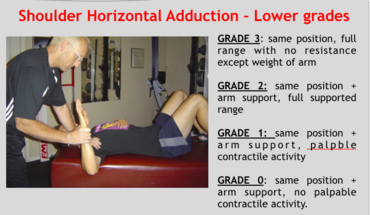Shoulder Mobilization
Original Editor - David Drinkard, Dana Tew.
Top Contributors - Dana Tew, Nupur Smit Shah, David Drinkard, Braden Osman, Admin, Jacob Bischoff, Kim Jackson, Lucinda hampton, Aminat Abolade, 127.0.0.1, Rachael Lowe, Kai A. Sigel, WikiSysop, Tony Varela and Mariam Hashem This page is under construction. Please come back soon.
Introduction[edit | edit source]
Shoulder mobilization is commonly used in clinical practice. It is applied in cases where the ROM is restricted. Shoulder mobilization (Maitland technique) is described on this page.
Manual therapy interventions for the shoulder have been associated with improvements in pain and function in individuals with :
Below are some of the techniques at our disposal.
Posterior Glenohumeral Mobilization[edit | edit source]
- Patient Position: Supine
- Therapist Position: Force Hand on Proximal Humerus
- Mobilization: A posteriorly directed force is directed perpendicular to the humerus
Inferior Glenohumeral Mobilization[edit | edit source]
Scapulothoracic Mobilization[edit | edit source]
Scapulothoracic mobilization is performed when there is dysfunction of the scapulothoracic articulation (e.g. restriction of upward rotation or lateral glide). Mobilizations that are commonly used include medial/lateral glides, superior/inferior glides, upward and downward rotation, and diagonal patterns.
- Patient position- typically, the patient is lying side-lying with the involved side up and the arm resting on the therapist's arm. The therapist stands in front of the patient, facing them. Hand contacts for these glides are the inferior angle of the scapula and the acromion. Direction and magnitude of force are dependent upon the technique being utilized and the amount of motion that is desired.[4]
References[edit | edit source]
- ↑ medbridge Manual Therapy Available: https://www.medbridgeeducation.com/techniques/evidence/2-Shoulder/ (accessed 30.9.2021)
- ↑ Posterior Glide to increase flexion and internal rotation. Available from: https://www.youtube.com/watch?v=At5YYf-LtjU
- ↑ Manual Therapy for the glenohumeral joint. Available from: https://www.youtube.com/watch?v=XnynTee7kak
- ↑ Hertling D, Kessler RM. Management of Common Musculoskeletal Disorders: Physical Therapy Principles and Methods. 4th ed. LW&W, Philadephia, 2006.







